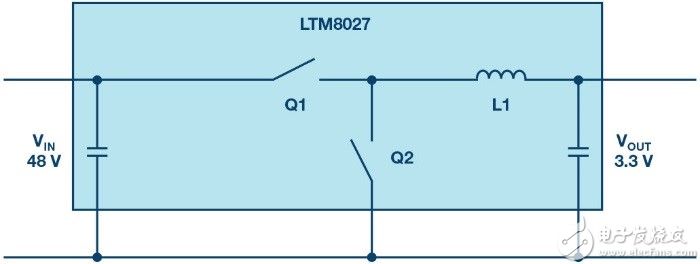How do you improve efficiency for power converters that convert high voltage inputs to low voltage outputs? The answer is that the industry has developed many different solutions for applications that require high input voltages to be converted to very low output voltages. An example of this is the conversion from 48 volts to 3.3 volts. Such buck specifications are common in servers in the information technology field, as well as in various telecommunications applications.
 Figure 1 converts from 48 volts to 3.3 volts through only one conversion step.
Figure 1 converts from 48 volts to 3.3 volts through only one conversion step.
If a buck converter (buck) is used in this single conversion step, as shown in Figure 1, there is a problem that the duty cycle is low. The duty cycle is the ratio between the running time (the main switch is on) and the off time (the main switch is off). The duty cycle of the buck conversion is calculated by the following formula:

Based on an input voltage of 48 volts (V) and an output voltage of 3.3 volts, the duty cycle is calculated to be approximately 7%. This means that at a switching frequency of 1 MHz (1,000 nanoseconds (ns) per switching cycle), the Q1 switch has only 70 nanoseconds in the ON state. For such circuits, a switching regulator is usually used to keep the startup time below 70 nanoseconds. But if you choose such a component, there will be another challenge.
If the buck regulator with extremely high power conversion efficiency operates in a very short duty cycle, its conversion efficiency will drop because the time it can be used to store power into the inductor becomes very small. The system needs to provide the power required for operation through the inductive component in an extremely long off state. Therefore, such a setting usually causes the peak current of the circuit to become extremely high. In order to reduce these spike currents, the inductance of L1 must be pulled high because L1 experiences a very high voltage difference during the startup state, as shown in Figure 1.
In this example, it can be observed that in the startup state there is approximately 44 volts of electrical inductance through the inductor, 48 volts on the side of the switching node, and 3.3 volts on the output side. The current of the inductor can be calculated by the following formula:

If a high voltage is passed through the inductor, the current will rise for a fixed period of time while the inductor value remains fixed. To reduce the peak current of the inductor, a higher inductance value must be used. However, a higher inductance value will increase the power consumption. Under these voltage conditions, Analog Devices' high-efficiency LTM8027 μModule regulator achieves 80% power efficiency at 4 amps of output current.
 Figure 2 The voltage is converted from 48 volts to 3.3 volts in two steps, and an intermediate voltage of 12 volts is used in the process.
Figure 2 The voltage is converted from 48 volts to 3.3 volts in two steps, and an intermediate voltage of 12 volts is used in the process.
A circuit solution that is often used and more efficient in the industry to increase power efficiency is to generate an intermediate voltage. The two high efficiency buck regulators are placed in an overlapping configuration as shown in Figure 2. In the first step, the 48 volts voltage drops to 12 volts and then drops to 3.3 volts in the second step. The μModule regulator has a conversion efficiency of over 92% when it is reduced from 48 volts to 12 volts. The second step from 12 volts to 3.3 volts uses the LTM4624 with a conversion efficiency of 90% and a total power conversion efficiency of 83%, which is 3% higher than the direct conversion method shown in Figure 1.
This result is surprising because the 3.3 volt output supply must go through two separate switching regulator circuits. The circuit shown in Figure 1 is less efficient because of its short duty cycle and the formation of high inductance spike currents.
When comparing single-step buck architectures with intermediate buffered bus architectures, many factors beyond power efficiency must be considered. But this article only discusses several key points of power conversion efficiency. One solution to this fundamental problem is the new LTC7821, a hybrid buck controller that combines a charge pump with a buck regulator to turn the duty cycle into a VIN/VOUT ratio of 2 Double, so it can reach a very high step-down ratio with extremely high power conversion efficiency.
The generation of the intermediate voltage is very useful for improving the overall conversion efficiency of the power supply. The industry has made considerable progress in this type of extremely short duty cycle to improve conversion efficiency, as shown in Figure 1, such as the use of very fast gallium nitride (GaN) switch to help reduce switching losses, and thus improve the power supply Conversion efficiency. However, the current cost of such a solution is higher than the overlapping configuration solution shown in Figure 2.
Female headphones are specially designed for women, with pink, rose gold or rose red as the main color, which are very popular among female customers. Mainly divided into: headband female headphones, in-ear female earphones, diamond female headphones. With skin-friendly materials, it is comfortable to wear and beautiful in appearance.

Feminine Headphones,Waterproof Headphones,Disposable Headphone,Female Headphones
Shenzhen Linx Technology Co., Ltd. , https://www.linxheadphone.com